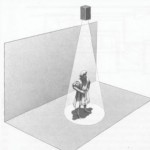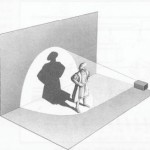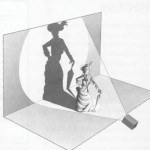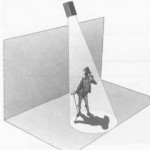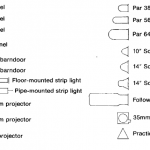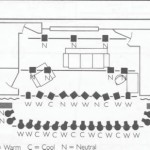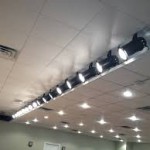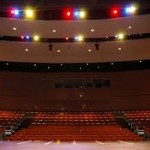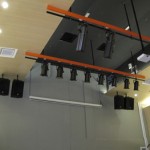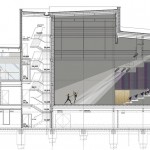A GUIDE TO LIGHTING
Whatever the scale of a production – amateur or professional – lighting like other design processes is based on a sequence of logical decisions plus a good measure of creative inspiration. This brief guide offers a sequence of step-by-step decisions to form the basis of a lighting process for the smaller scale production. It has been prepared by a lighting designer with experience of working on productions of all types and sizes. We hope that it will be especially helpful to amateur groups, small touring companies and educational theatre.
Types of Light
How do we choose which type to use in each position? As lighting equipment is so robust choice is further complicated, in that in addition to the range in today’s catalogue, many earlier models are still in use. However lighting instruments group into families and it is convenient to consider our requirements in terms of what each family offers in terms of beam size, beam shape, and beam quality.
Floods
The beam size, shape and quality emitted by a flood is fixed: there are no adjusting knobs. The light is therefore suitable for lighting skies and cloths. It is not selective enough for lighting actors. Strand Lighting Coda units may be single or grouped in 3s or 4s for colour mixing. They have areflector that is specially designed to ensure an even wash over a large area from a short throw
Soft Spots
Prism Convex (PC) spots allow control of the beam size, and the beam may be roughly shaped by a rotatable barndoor. The quality is evenand soft-edged, with less light-spill outside the main beam than in the case of a fresnel. In addition to the PC’s, Fresnels have a very softedge. The beam angle is adjustable and its shape roughly containable by a 4-leaf rotatable barndoor. The extent of the spill outside themain beam makes them unsuitable for longer throws, particularly from the auditorium.
Profile Spots
Profile spots give precise control of the beam. An iris diaphragm (for round edges) and shutters (for hard edges) can produce shapes in all sizes. For more complex shapes, special masks can be cut. Edge quality can be adjusted from very soft to very hard by moving the lens,while a metal pattern plate called a gobo can texture the quality of the whole beam. The number in the profile’s name indicates the beamangle.
Whereas standard profile spots have a fixed beam angle, which is narrowed by shuttering, variable beam profiles use a pair of lenses whose differential movement gives a wide range of beam angles and edge qualities. The shutters are then only required for shaping. Adjustmentsare faster and more efficient use is made of the lamp’s output The number in a variable profile’s name indicates the range of available angles.
The SL New Generation Profile Spots, from Strand Lighting, now provide increased light output with reduced power consumption. Often referred to as a “coolbeam” profile, they do this by using state of the art optical coating on a glass reflector, allowing the optical light to be passed forward,while the heat and infra red spectrum is allowed out of the rear.
Beamlights
Most lighting instruments produce a conical beam so that the spread widens as the throw increases. Beamlights use a parabolic reflector(and no lens) to produce a near parallel beam which is more intense than a lens spotlight of the same wattage. This is one of the more important developments of the past decade. The optics are fully contained within the glass envelope of the lamp. Various Lamps providing angles of a squashed near-parallel beam are available. The intensity produces a depth-enhancing haze in the air, so intense that it is effective even with deep colours. The basis of most rock lighting today.
CHOOSING LIGHTING POSITIONS
Lighting from the front
Consider the effect of a light startingas a vertical downlight on an actor thenmoving in a frontal plane until its beambecomes horizontal and then carries on to light from below. How visible will be the actor’s face, particularly eyes and teeth? To what extent will face and body be modelled or flattened? Whatarea of stage will be selected and what will be the size and direction of shadows cast on floor and scenery?
GALLERY

